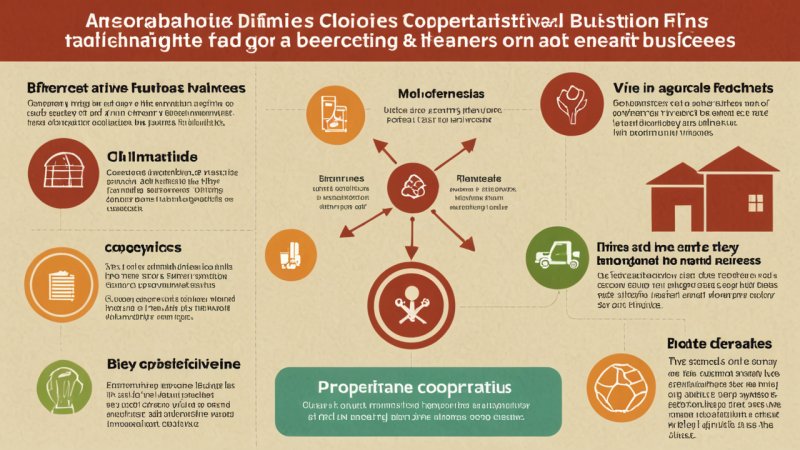In the realm of local economies, cooperatives and traditional businesses represent two distinct approaches to economic development and community engagement. While both aim to provide goods and services, their underlying philosophies, structures, and impacts on communities can differ significantly. This article seeks to compare these two models, focusing on their pros, cons, and the unique roles they play in fostering local economic resilience.
Understanding Cooperatives
Cooperatives, often referred to as co-ops, are member-owned businesses that operate for the benefit of their members. They can take many forms, including consumer cooperatives, worker cooperatives, and producer cooperatives. The key characteristic of cooperatives is their democratic governance structure, where each member typically has an equal vote, regardless of their level of investment.
Pros of Cooperatives
- Member-Centric: Cooperatives prioritize the needs and interests of their members, fostering a sense of community and shared purpose.
- Economic Equity: They promote fair wages and equitable distribution of profits, contributing to income stability among members.
- Resilience: Co-ops often demonstrate greater resilience during economic downturns due to their focus on community needs over profit maximization.
- Local Investment: Profits are typically reinvested in the local community, enhancing local economic development.
Cons of Cooperatives
- Capital Challenges: Raising capital can be more difficult for cooperatives, as they cannot sell shares in the same way traditional businesses can.
- Management Complexity: The democratic governance model can lead to slower decision-making processes, as consensus is often required.
- Limited Reach: Co-ops may struggle to compete with larger corporations that benefit from economies of scale.
Understanding Traditional Businesses
Traditional businesses, which include sole proprietorships, partnerships, and corporations, are typically structured to maximize profit for owners and shareholders. They can be small local establishments or large multinational corporations. The governance structure is usually hierarchical, concentrating decision-making power in the hands of a few.
Pros of Traditional Businesses
- Access to Capital: Traditional businesses can attract investment more easily, allowing for rapid growth and expansion.
- Efficiency: The hierarchical structure often leads to quicker decision-making processes, enabling businesses to adapt swiftly to market changes.
- Market Reach: Larger traditional businesses can leverage economies of scale, offering lower prices and a wider variety of products.
Cons of Traditional Businesses
- Profit-Driven: The primary focus on profit can lead to practices that undermine community welfare, such as underpaying workers or neglecting environmental responsibilities.
- Income Inequality: Traditional businesses often exacerbate income inequality, as profits are concentrated among owners and shareholders.
- Vulnerability to Economic Shifts: Solely profit-driven entities may be less resilient during economic downturns, leading to layoffs and closures.
Comparative Analysis of Impact on Local Economies
When considering the impact of cooperatives versus traditional businesses on local economies, several factors come into play. Cooperatives tend to strengthen community ties by prioritizing local needs, while traditional businesses may contribute to economic growth through job creation and investment. However, the sustainability of these contributions can vary.
Community Engagement
Cooperatives often engage community members in decision-making processes, fostering a sense of ownership and accountability. In contrast, traditional businesses may prioritize shareholder interests over community engagement, potentially leading to a disconnect between the business and local residents.
Economic Stability
The emphasis on equitable practices in cooperatives can lead to more stable income for workers, thereby reducing poverty levels in the community. Traditional businesses, while capable of generating significant revenue, can also contribute to economic volatility, especially if they operate on thin profit margins.
Environmental Considerations
Many cooperatives are founded with a commitment to sustainable practices, often prioritizing environmental stewardship as part of their mission. Traditional businesses, depending on their corporate policies, can sometimes prioritize profit over environmental concerns, leading to practices that harm local ecosystems.
Conclusion
In summary, both cooperatives and traditional businesses play essential roles in local economies. Cooperatives offer a model that emphasizes community well-being, equitable practices, and sustainability, while traditional businesses can drive economic growth and innovation. The choice between these models often depends on the specific needs and values of a community. For those seeking to foster a more equitable and sustainable local economy, supporting cooperatives may be a more aligned approach, whereas traditional businesses can provide necessary goods and services that meet immediate market demands. Ultimately, a balanced ecosystem that includes both models may be the most beneficial for thriving local economies.






